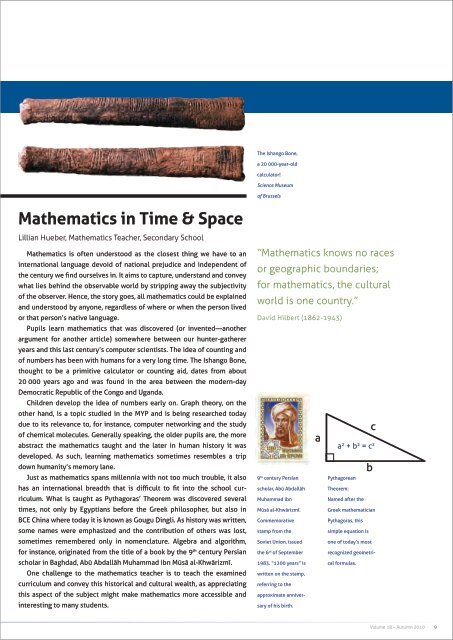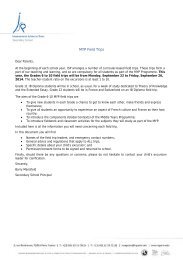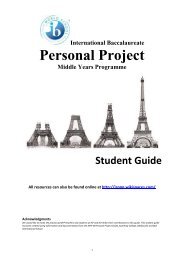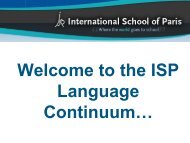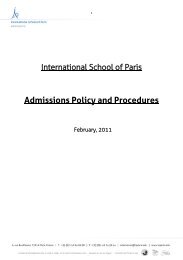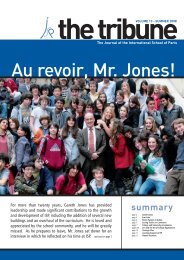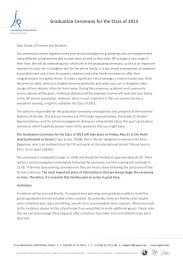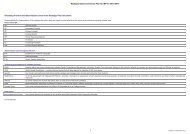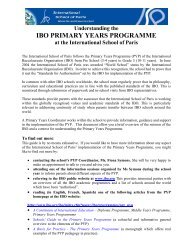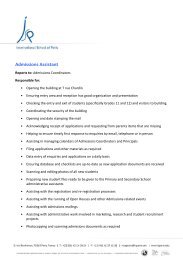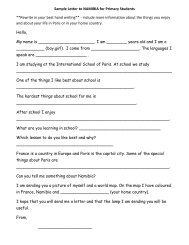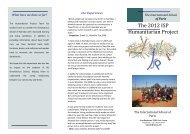“I’ve Always Loved Math!”An interview with Sophie Diamond, Grade 12Sophie is currently enjoying thechallenges <strong>of</strong> high-level mathwith Mr. Kerr. She stopped byour <strong>of</strong>fice one day to share someinsights into why math is one <strong>of</strong>her favorite subjects:What has been your history withmathematics?I have always loved math. WhenI was in middle school, however, Ihad a math teacher who was veryexacting and intimidating. We wereall afraid <strong>of</strong> him! However, when Ientered high school, I had a series<strong>of</strong> excellent math teachers whomade the subject enjoyable again.What changed in high school?I used to get stuck on a problemand just stop working on it. What Ilearned from these good teacherswas to try a different approach, adifferent path to finding the rightanswer. Math became fun again!How would you help a student whois having trouble with math?I would say to watch out forthose trigonometry identities;there are a lot <strong>of</strong> questions thatseem simple at first, but then youend up going around in circles.<strong>The</strong>re are tricks you can learn tohelp you understand. When itworks—like with vectors and 3-Dplanes—it is a really great feeling!Beyond good teachers, what hashelped you feel comfortablewith math?I tutored young students inmath. Teaching helped me learna lot, not only in reviewing whatI had already learned, but knowingthat I could help kids reallyunderstand and get it.Any final thoughts?I’m not in high-level math justto try to get a 7 on the IB diplomaexam; I am in this class becauseI truly enjoy what the IB Mathcourse teaches. We cover so manydifferent topics, and we do so withlots <strong>of</strong> depth. Because I am alsointerested in English literature andhistory, I am applying to liberal artscolleges where I will be able tocontinue exploring different fields.Another reason I love math is thatit also appeals to my more creativeside; there are lots <strong>of</strong> differentways to get to the right answer.You learn a lot more by takingthese less-obvious paths wherethere is more room for creativity.So, who knows? I might be amathematician or a poet!<strong>The</strong>ory <strong>of</strong> Knowledge and MathematicsDr. Soraya Fathi, Mathematics & ToK Teacher, Secondary <strong>School</strong><strong>The</strong>ory <strong>of</strong> Knowledge (ToK) is designed to give grade11–12 Diploma students an opportunity to reflect onwhat it means to know something and on how theychange as their knowledge changes. <strong>The</strong> course tries todefine what knowledge and knowing are; it moves intodifferent ways <strong>of</strong> knowing and areas <strong>of</strong> knowledge, andit also looks at knowledge and values—especially ethicalvalues and decisions that we all face.Within the <strong>The</strong>ory <strong>of</strong> Knowledge course, mathematicsis discussed as an area <strong>of</strong> knowledge on its own. <strong>The</strong>purpose <strong>of</strong> the module is not to learn new mathematicalconcepts. Rather, students focus on what mathematicsis, and on how mathematical knowledge differsfrom other areas <strong>of</strong> our life.Central questions to the module are: What is mathematics?How do you know that various mathematicalstatements are true? Is mathematics driven by culturalassumptions and beliefs? Does mathematics describereality? Is mathematics a language?Students address these questions by exploring topics<strong>of</strong> discussion such as Fermat’s last theorem, thenotion <strong>of</strong> mathematical pro<strong>of</strong>, geometry as an axiomaticsystem, and mathematical deduction versusexperimental induction. Certainly exploring mathematicsfrom a ToK perspective provides students withthe opportunity to enrich and broaden their view onthe subject by reflecting critically on what it means tothink mathematically.8 the tribune — <strong>The</strong> Journal <strong>of</strong> the <strong>International</strong> <strong>School</strong> <strong>of</strong> <strong>Paris</strong> — www.isparis.edu
<strong>The</strong> Ishango Bone,a 20 000-year-oldcalculator!Science Museum<strong>of</strong> BrusselsMathematics in Time & SpaceLillian Hueber, Mathematics Teacher, Secondary <strong>School</strong>Mathematics is <strong>of</strong>ten understood as the closest thing we have to aninternational language devoid <strong>of</strong> national prejudice and independent <strong>of</strong>the century we find ourselves in. It aims to capture, understand and conveywhat lies behind the observable world by stripping away the subjectivity<strong>of</strong> the observer. Hence, the story goes, all mathematics could be explainedand understood by anyone, regardless <strong>of</strong> where or when the person livedor that person’s native language.Pupils learn mathematics that was discovered (or invented—anotherargument for another article) somewhere between our hunter-gathereryears and this last century’s computer scientists. <strong>The</strong> idea <strong>of</strong> counting and<strong>of</strong> numbers has been with humans for a very long time. <strong>The</strong> Ishango Bone,thought to be a primitive calculator or counting aid, dates from about20 000 years ago and was found in the area between the modern-dayDemocratic Republic <strong>of</strong> the Congo and Uganda.Children develop the idea <strong>of</strong> numbers early on. Graph theory, on theother hand, is a topic studied in the MYP and is being researched todaydue to its relevance to, for instance, computer networking and the study<strong>of</strong> chemical molecules. Generally speaking, the older pupils are, the moreabstract the mathematics taught and the later in human history it wasdeveloped. As such, learning mathematics sometimes resembles a tripdown humanity’s memory lane.Just as mathematics spans millennia with not too much trouble, it alsohas an international breadth that is difficult to fit into the school curriculum.What is taught as Pythagoras’ <strong>The</strong>orem was discovered severaltimes, not only by Egyptians before the Greek philosopher, but also inBCE China where today it is known as Gougu Dingli. As history was written,some names were emphasized and the contribution <strong>of</strong> others was lost,sometimes remembered only in nomenclature. Algebra and algorithm,for instance, originated from the title <strong>of</strong> a book by the 9 th century Persianscholar in Baghdad, Abū Abdallāh Muhammad ibn Mūsā al-Khwārizmī.One challenge to the mathematics teacher is to teach the examinedcurriculum and convey this historical and cultural wealth, as appreciatingthis aspect <strong>of</strong> the subject might make mathematics more accessible andinteresting to many students.“Mathematics knows no racesor geographic boundaries;for mathematics, the culturalworld is one country.”David Hilbert (<strong>18</strong>62-1943)aa 2 + b 2 = c 2 cb9 th century PersianPythagoreanscholar, Abū Abdallāh <strong>The</strong>orem:Muhammad ibnNamed after theMūsā al-Khwārizmī.Greek mathematicianCommemorativePythagoras, thisstamp from thesimple equation isSoviet Union, issuedone <strong>of</strong> today’s mostthe 6 th <strong>of</strong> Septemberrecognized geometricalformulas.1983. “1200 years” iswritten on the stamp,referring to theapproximate anniversary<strong>of</strong> his birth.<strong>Vol</strong>ume <strong>18</strong> – Autumn 2010 9


